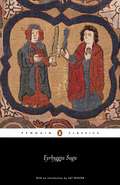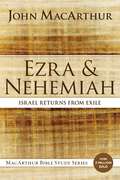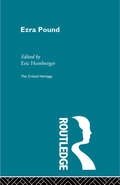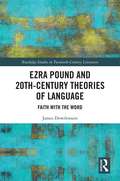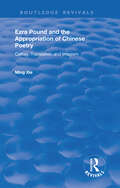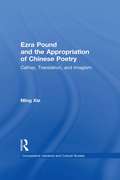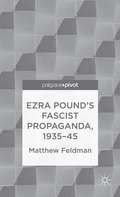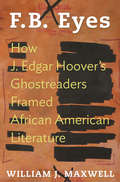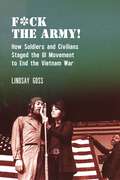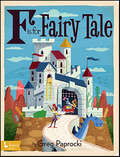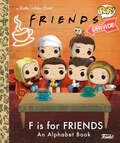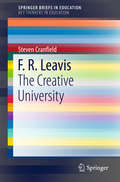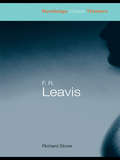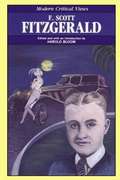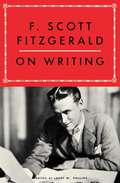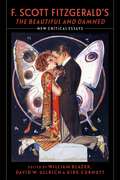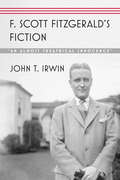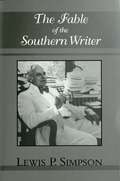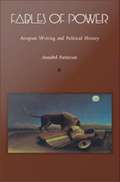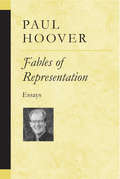- Table View
- List View
Eyrbyggja Saga
by Hermann PalssonAn Icelandic saga which mixes realism with wild gothic imagination and history with eerie tales of hauntings. It dramatizes a 13th century view of the past, from the pagan anarchy of the Viking age to the settlement of Iceland, the coming of Christianity and the beginnings of organized society.
Ezra and Nehemiah: Israel Returns from Exile (MacArthur Bible Studies #11)
by John F. MacArthurThe people of Israel were carried away to Babylon, where they lived as exiles and outcasts. God sent this judgment on His people because of their continued unfaithfulness to His word—but the day came when He called them to return to Jerusalem. However, when they arrived there, they discovered things had dramatically changed for the worse. The Temple was destroyed, the city walls were torn down, and the land had been taken over by people who did not want them back. There was work to be done, and it was not going to be easy.In this study, pastor John MacArthur will guide you through an in-depth look at the historical period beginning with Ezra's early return to Jerusalem, continuing through the teachings of Israel's prophets during the time, and concluding with Nehemiah and the people's rebuilding efforts in the city. Studies include close-up examinations of Ezra, Nehemiah, Haggai, Zechariah, and others, as well as careful considerations of doctrinal themes such as "Unequally Yoked" and "Worshiping God."—ABOUT THE SERIES—The MacArthur Bible Study series is designed to help you study the Word of God with guidance from widely respected pastor and author John MacArthur. Each guide provides intriguing examinations of the whole of Scripture by examining its parts and incorporates:Extensive, but straight-forward commentary on the text.Detailed observations on overriding themes, timelines, history, and context.Word and phrase studies to help you unlock the broader meaning and apply it to your life.Probing, interactive questions with plenty of space to write down your response and thoughts.
Ezra Pound
by Betsy ErkkilaNo one better symbolizes the course of modern literature its triumphs and defeats than Pound. From the dreaminess and aestheticism of his early poems, to his Imagist and Vorticist manifestos, to the formally experimental method and mythic engagement with history in The Cantos, Pound marks the path that modern and postmodern poetry would follow. This collection provides a documentary record of the reviews of Ezra Pound's work in contemporary journals and newspapers, an introduction that traces the public outrage and controversy that characterized Pound's reception, and checklists of all known reviews of Pound's work. Most of the major poets and critics of the twentieth-century reviewed Pound's work, including T. S. Eliot, Ford Maddox Ford, William Carlos Williams and Edmund Wilson. Their multiple, perplexed, and sometimes hostile responses to his work provide a rich record of the struggles that marked the emergence of modern and contemporary poetry and poetics.
Ezra Pound (Collected Critical Heritage Ser. #Series 2)
by Eric HombergerThis set comprises 40 volumes covering nineteenth and twentieth century European and American authors. These volumes will be available as a complete set, mini boxed sets (by theme) or as individual volumes. This second set compliments the first 68 volume set of Critical Heritage published by Routledge in October 1995.
Ezra Pound and 20th-Century Theories of Language: Faith with the Word (Routledge Studies in Twentieth-Century Literature)
by James DowthwaiteEzra Pound is one of the most significant poets of the twentieth century, a writer whose poetry is particularly notable for the intensity of its linguistic qualities. Indeed, from the principles of Imagism to the polyphony of his Cantos, Pound is central to our conception of modernism’s relationship with language. This volume explores the development of Pound’s understanding of language in the context of twentieth-century linguistics and the philosophy of language. It draws on largely unpublished archival material in order to provide a broadly chronological account of the development of Pound’s views and their relation to both his own poetry and to modernist writing as a whole. Beginning with Pound’s contentious relationship with philology and his antagonism towards academia, the book traces continuities and shifts across Pound’s career, culminating in a discussion of the centrality of language to the conception of his Cantos. While it contains discussions around significant figures in twentieth-century linguistic thought, such as Ferdinand de Saussure and Ludwig Wittgenstein, the book attempts to recover the work of theorists such as Leonard Bloomfield, Lucien Lévy-Bruhl, and C.K. Ogden, figures who were once central to modernism, but who have largely been pushed to the periphery of modernist studies. The picture of Pound that emerges is a figure whose understanding of language is not only bound up with modernist approaches to anthropology, politics, and philosophy, but which calls for a new understanding of modernism’s relationship to each.
Ezra Pound and the Appropriation of Chinese Poetry: Cathay, Translation, and Imagism (Comparative Literature And Cultural Studies)
by Ming XieFirst published in 1999. The subject of this book is the translation and appropriation of Chinese poetry by some English and American writers in the early decades of this century. The author explores the be concerned as much with English translation of Chinese poetry per se as with the relationship between this body of translation from the Chinese and the developing poetics and practices of what is usually referred to as "Imagism," as much with the question of historical influence or ascription as with certain interpretive and critical aspects of this correlative relationship. Focusing on the direct influence of Chinese poetry upon the theory and practice of Imagism, attributing to Imagist poets in general and Ezra Pound in particular the perception in Chinese poetry of the essential qualities and principles for rejuvenating English poetry in the early decades of the century.
Ezra Pound and the Appropriation of Chinese Poetry: Cathay, Translation, and Imagism (Comparative Literature and Cultural Studies #6)
by Ming XieThis book focuses on the relations between the translation and appropriation of classical Chinese poetry by Ezra Pound and some of his contemporaries and the development of Anglo-American Imagist poetry and poetics. It is concerned as much with critical aspects of this correlative relationship as with the question of historical influence and ascription. The author places the early work of Ezra Pound in the context of works of Chinese translation by other contemporary poet-translators such as Arthur Waley and Amy Lowell, and examines the whole notion of an ideogrammic poetry as advocated by Ernest Fenollosa and Ezra Pound against an appropriately reconstructed historical and critical context of poetic theory and practice. Closely linked to this is a discussion of Pound's use of personae and modulation of the elegiac in relation to the immediately preceding context of late Victorian elegiac lyricism and Brownigesque dramatic monologue. Through a series of close readings of translations from the Chinese, especially those by Pound, the author shows how the critical problem of what is involved in translating a Chinese poem into a new English poem is closely linked to the particulars of early Modernist literary history. In particular, through tracing the trajectory of a number of central issues and notions, such as absolute, free-floating, metaphor, metaphor as epiphanic image and its relation to syntax, metaphor and parallelism, experiments with rhythm and cadence, the book explores some of the reasons for Fenollosa's and Pound's emphasis on the visual image, the notion of phanopoeia and ideogrammic verbal action as the active perceiving of relations, and closely examines the genesis and significance of Pound's ideogrammic method, as well as the question of cultural misreading and vicarious envisagement, and provides a critical overview of Pound's general engagement with translation.
Ezra Pound’s Fascist Propaganda, 1935–45
by Matthew FeldmanEzra Pound was an influential propagandist for British, Italian and ultimately German fascist movements. Using long-neglected manuscripts and cutting-edge approaches to fascism as a 'political religion', Feldman argues that Pound's case offers a revealing case study of a modernist author turned propagator of the 'fascist faith'.
F.B. Eyes
by William J. MaxwellFew institutions seem more opposed than African American literature and J. Edgar Hoover's white-bread Federal Bureau of Investigation. But behind the scenes the FBI's hostility to black protest was energized by fear of and respect for black writing. Drawing on nearly 14,000 pages of newly released FBI files, F.B. Eyes exposes the Bureau's intimate policing of five decades of African American poems, plays, essays, and novels. Starting in 1919, year one of Harlem's renaissance and Hoover's career at the Bureau, secretive FBI "ghostreaders" monitored the latest developments in African American letters. By the time of Hoover's death in 1972, these ghostreaders knew enough to simulate a sinister black literature of their own. The official aim behind the Bureau's close reading was to anticipate political unrest. Yet, as William J. Maxwell reveals, FBI surveillance came to influence the creation and public reception of African American literature in the heart of the twentieth century.Taking his title from Richard Wright's poem "The FB Eye Blues," Maxwell details how the FBI threatened the international travels of African American writers and prepared to jail dozens of them in times of national emergency. All the same, he shows that the Bureau's paranoid style could prompt insightful criticism from Hoover's ghostreaders and creative replies from their literary targets. For authors such as Claude McKay, James Baldwin, and Sonia Sanchez, the suspicion that government spy-critics tracked their every word inspired rewarding stylistic experiments as well as disabling self-censorship. Illuminating both the serious harms of state surveillance and the ways in which imaginative writing can withstand and exploit it, F.B. Eyes is a groundbreaking account of a long-hidden dimension of African American literature.
F*ck The Army!: How Soldiers and Civilians Staged the GI Movement to End the Vietnam War (Performance and American Cultures #7)
by Lindsay GossReveals the theatrical dimensions of civilian support for the revolutionary GI Movement of the 1960s-70sPerformance played a role both crucial and complicated in the antiwar activism of the 1960s and 1970s. As soldiers and civilian actors, activists, and celebrities worked together to end the Vietnam War, their theatrical acts of solidarity and resistance connected liberation struggles across the lines of race, gender, enlisted status, and nationality.F*ck The Army! offers the first, fully narrated history of the FTA, an antiwar variety show featuring Jane Fonda that played to tens of thousands of active-duty troops over the course of nine months in 1971. From its very conception, the civilian-led show was directed towards the project of making visible the growing antiwar movement organized by GIs, inspired by but also acting as a rebuttal to the increasingly out-of-touch USO tours presented by Bob Hope. Through an analysis of the FTA’s tactical performances of solidarity and resistance, Lindsay Goss brings into view the theatrical dimensions of the GI movement itself, revealing it as representative of the revolutionary and theatrical politics and tactics of the period. The volume highlights how, due to the movement’s subsequent historical erasure, a renewed anti-theatricality emerged from the 1960s and became a potent feature of contemporary political discourse.The author’s deft methodological and analytic strategies, in tandem with her elegantly accessible style demonstrate how seemingly little-known performance practices can activate consequential understandings of what we thought we knew about the recent past. At the same time, she encourages essential conversations about pressing contemporary issues that demand our attention. At its core, F*ck The Army! reveals the fundamentally theatrical character of radical activism when it seeks to challenge the status quo.
F Is for Fairy Tale
by Greg PaprockiAn engaging collection of 26 illustrations featuring many different fairy tales and fairy tale objects—such as Castle, for Cinderella; Lamp, for Aladdin; Tower, for Rapunzel; and Red Roses, for Alice in Wonderland. Teach your little ones to be just like a fairy tale hero with words such as Brave, for the brave little goat in Three Billy Goats Gruff; Fearless, for small Thumbelina who floats down a river; and Mighty, for the mighty little boy who pulls a sword from a stone. Illustrator Greg Paprocki’s popular BabyLit alphabet board books feature his classically retro midcentury art style that’s proven to be a hit with both toddlers and adults.
F Is for First State: A Delaware Alphabet
by Carol CraneBeginning readers will enjoy the simple rhymes while older children discover facts about each topic letter in the sidebar expository. State symbols such as the Blue Hen Chicken and peach blossom speak to the character and traditions that formed the state. F is for the First State-- first to confirm our Constitution. F is also for our Flag, with honored colors in our nation.
F is for Friends: An Alphabet Book (Little Golden Book)
by Mary Man-KongRachel, Ross, Monica, Joey, Chandler, Phoebe and all the gang star in this first-ever Funko Pop! Friends ABC Little Golden Book!A is for Apartment, B is for Ball, and C is for Couch! Friends fans can learn their ABCs with the adorable Funko Pop! versions of Rachel, Ross, Monica, Joey, Chandler, and Phoebe in this Friends alphabet Little Golden Book—perfect for children 2 to 5, as well as fans and collectors of all ages.Little Golden Books enjoy nearly 100% consumer recognition. They feature beloved classics, hot licenses, and new original stories. . . the classics of tomorrow.
F. R. Leavis
by Steven CranfieldThis is a critical introduction to the educational thought of F. R. Leavis (1895-1978), the greatest English literary critic of the twentieth century, providing the first in-depth examination of Leavis's ideas in relation to contemporary mass higher education. During the course of a long, prolific and controversial academic career, which saw him take issue with figures such as Wittgenstein, T. S. Eliot and C. P. Snow, Leavis became one of the most articulate advocates for the idea of the university as 'a centre of consciousness and human responsibility' in the face of what he saw as the relentless technological drive of civilisation. With the journal Scrutiny which he co-founded, as well as his critical writings, Leavis became a decisive influence on generations of teachers in Britain and overseas. Widely misrepresented as narrowly elitist, his ideas about 'the creative university', with their radical, student-centred approach to teaching, constitute a powerful resource for a higher education system grappling with the contradictory demands of continuity and change. Based on original research, the study provides an overview of Leavis's life, work and heritage and his educational world view, and a comprehensive exploration of Leavis's pedagogy from theoretical and practical perspectives. It also includes afirst-hand account by the author of being taught by Leavis in person.
F.R. Leavis: Essays And Documents (Routledge Critical Thinkers)
by Richard Storer‘informative, succint, circumspect; an exacting introduction to Leavis as an incisive master critic. Ideal for today’s students and general readers’ – Chris Terry, Times Higher Education F.R. Leavis is a landmark figure in twentieth-century literary criticism and theory. His outspoken and confrontational work has often divided opinion and continues to generate interest as students and critics revisit his highly influential texts. Looking closely at a representative selection of Leavis’s work, Richard Storer outlines his thinking on key topics such as: literary theory, ‘criticism’ and culture canon formation modernism close reading higher education. Exploring the responses and engaging with the controversies generated by Leavis’s work, this clear, authoritative guide highlights how Leavis remains of critical significance to twenty-first-century study of literature and culture.
F. Scott Fitzgerald, A Biography
by Andre Le Vot William ByronA carefully crafted biography with literary criticism.
F. Scott Fitzgerald in Context
by Bryant MangumThe fiction of F. Scott Fitzgerald serves as a compelling and incisive chronicle of the Jazz Age and Depression Era. This collection explores the degree to which Fitzgerald was in tune with, and keenly observant of, the social, historical and cultural contexts of the 1920s and 1930s. Original essays from forty international scholars survey a wide range of critical and biographical scholarship published on Fitzgerald, examining how it has evolved in relation to critical and cultural trends. The essays also reveal the micro-contexts that have particular relevance for Fitzgerald's work – from the literary traditions of naturalism, realism and high modernism to the emergence of youth culture and prohibition, early twentieth-century fashion, architecture and design, and Hollywood – underscoring the full extent to which Fitzgerald internalized the world around him.
F. Scott Fitzgerald (Modern Critical Views)
by Harold BloomCommentary on the life and works of the author.
F. Scott Fitzgerald On Writing
by Larry W. Phillips F. Scott FitzgeraldA collection of F. Scott Fitzgerald&’s remarks on his craft, taken from his works and letters to friends and colleagues—an essential trove of advice for aspiring writers. As F. Scott Fitzgerald famously decreed, &“An author ought to write for the youth of his own generation, the critics of the next, and the schoolmasters of ever after.&” Fitzgerald's own work has gone on to be reviewed and discussed for over one hundred years. His masterpiece The Great Gatsby brims with the passion and opulence that characterized the Jazz Age—a term Fitzgerald himself coined. These themes also characterized his life: Fitzgerald enlisted in the US army during World War I, leading him to meet his future wife, Zelda, while stationed in Alabama. Later, along with Ernest Hemingway and other American artist expats, he became part of the &“Lost Generation&” in Europe. Fitzgerald wrote books &“to satisfy [his] own craving for a certain type of novel,&” leading to modern American classics including Tender Is the Night, This Side of Paradise, The Beautiful and Damned. In this collection of excerpts from his books, articles, and personal letters to friends and peers, Fitzgerald illustrates the life of the writer in a timeless way.
F. Scott Fitzgerald's "The Beautiful and Damned": New Critical Essays
by Jackson R. Bryer Sarah Sue Goldsmith James L. West III Bonnie Shannon McMullen Walter Raubicheck Gail D. Sinclair Joseph K. Stitt Richard Webb Jr.F. Scott Fitzgerald’s second novel, The Beautiful and Damned, has frequently been dismissed as an outlier and curiosity in his oeuvre, a transitional work from the coming-of-age plot of This Side of Paradise to the masterful critique of American aspiration in The Great Gatsby. The Beautiful and Damned belongs to a genre that is widely misunderstood, the “bright young things” novel in which spoiled and wealthy characters succumb to decay because of their privilege and lack of purpose. Set between 1913 and 1922, Fitzgerald’s longest novel touches on many of the decisive issues that mark the passage from the Gilded Age and the Progressive Era into the Jazz Age: conspicuous consumption, income inequality, yellow journalism, the Great War, the rise of the movie industry, automobile travel, Wall Street stock scams, immigration and xenophobia, and the fixation with youth and aging. Published to coincide with the novel’s centennial in 2022, this collection approaches The Beautiful and Damned for its insights more than its faults. Prominent Fitzgerald scholars analyze major themes and reveal unappreciated issues with attention to history, biography, literary influence, gender studies, and narratology. While acknowledging the novel’s shortcomings, the essayists illustrate that The Beautiful and Damned has much more to say about its milieu than previously recognized. This collection provides a guide for understanding Fitzgerald’s aims while demonstrating the richness of ideas that this novel explores, alongside the anxieties and ambitions that reverberate within it.
F. Scott Fitzgerald’s Fiction: "An Almost Theatrical Innocence"
by John T. IrwinA personal interpretation of one of America’s most important writers."Fitzgerald’s work has always deeply moved me," writes John T. Irwin. "And this is as true now as it was fifty years ago when I first picked up The Great Gatsby. I can still remember the occasions when I first read each of his novels; remember the time, place, and mood of those early readings, as well as the way each work seemed to speak to something going on in my life at that moment. Because the things that interested Fitzgerald were the things that interested me and because there seemed to be so many similarities in our backgrounds, his work always possessed for me a special, personal authority; it became a form of wisdom, a way of knowing the world, its types, its classes, its individuals."In his personal tribute to Fitzgerald's novels and short stories, Irwin offers an intricate vision of one of the most important writers in the American canon. The third in Irwin's trilogy of works on American writers, F. Scott Fitzgerald’s Fiction resonates back through all of his previous writings, both scholarly and poetic, returning to Fitzgerald's ongoing theme of the twentieth-century American protagonist's conflict between his work and his personal life. This conflict is played out against the typically American imaginative activity of self-creation, an activity that involves a degree of theatrical ability on the protagonist's part as he must first enact the role imagined for himself, which is to say, the self he means to invent. The work is suffused with elements of both Fitzgerald's and Irwin's biographies, and Irwin's immense erudition is on display throughout. Irwin seamlessly ties together details from Fitzgerald's life with elements from his entire body of work and considers central themes connected to wealth, class, work, love, jazz, acceptance, family, disillusionment, and life as theatrical performance.
The Fable of the Southern Writer
by Lewis P. Simpson"With a breadth and depth unsurpassed by any other cultural historian of the South, Lewis Simpson examines the writing of southerners Thomas Jefferson, John Randolph, Mark Twain, Robert Penn Warren, Allen Tate, William Faulkner, Elizabeth Madox Roberts, Arthur Crew Inman, William Styron, and Walker Percy. Simpson offers challenging essays of easy erudition blessedly free of academic jargon.... [They] do not propose to support an overall thesis, but simply explore the southern writer's unique relationship with his or her region, bereft of myth and tradition, in the grasp of science and history." -- Library Journal
Fables of Power: Aesopian Writing and Political History
by Annabel PattersonIn this imaginative and illuminating work, Annabel Patterson traces the origins and meanings of the Aesopian fable, as well as its function in Renaissance culture and subsequently. She shows how the fable worked as a medium of political analysis and communication, especially from or on behalf of the politically powerless. Patterson begins with an analysis of the legendary Life of Aesop, its cultural history and philosophical implications, a topic that involves such widely separated figures as La Fontaine, Hegel, and Vygotsky. The myth's origin is recovered here in the saving myth of Aesop the Ethiopian, black, ugly, who began as a slave but become both free and influential, a source of political wisdom. She then traces the early modern history of the fable from Caxton, Lydgate, and Henryson through the eighteenth century, focusing on such figures as Spenser, Sidney, Lyly, Shakespeare, and Milton, as well as the lesser-known John Ogilby, Sir Roger L'Estrange, and Samuel Croxall. Patterson discusses the famous fable of The Belly and the Members, which, because it articulated in symbolic terms some of the most intransigent problems in political philosophy and practice, was still going strong as a symbolic text in the mid-nineteenth century, where it was focused on industrial relations by Karl Marx and by George Eliot against electoral reform.
Fables of Representation
by Paul HooverFrom the acclaimed author of Winter (Mirror) and Rehearsal in Black, Fables of Representation is a powerful collection of essays on the state of contemporary poetry, free from the stultifying theoretical jargon of recent literary history. With its title essay, "Fables of Representation," one of the most cogent studies ever written of the New York School of poets (a group that includes the influential poet John Ashbery), this book is required reading for anyone who seeks to understand the poetry and culture of the postmodern period. Author Paul Hoover's wide-ranging subjects include African-American interdisciplinary studies; the position of poetry in the electronic age; the notion of doubleness in the work of Harryette Mullen and others; the lyricism of the New York School poets; and the role of reality in American poetry. Hoover also introduces two provocative essays sure to generate attention and discussion: "The Postmodern Era: A Final Exam" and "The New Millennium: Fifty Statements on Literature and Culture."
